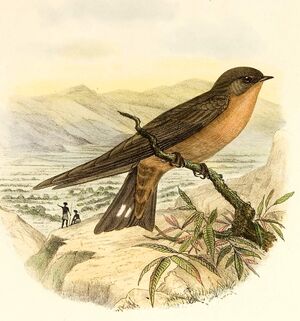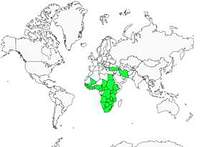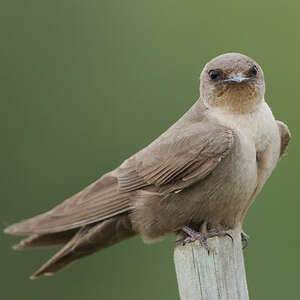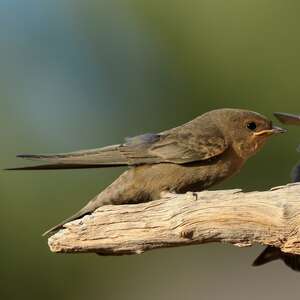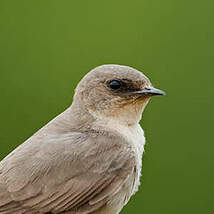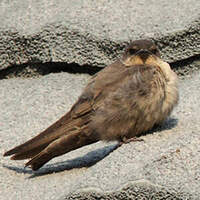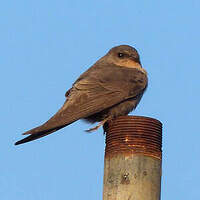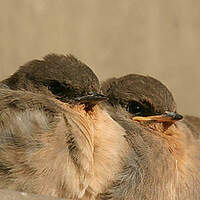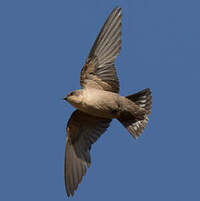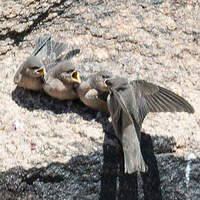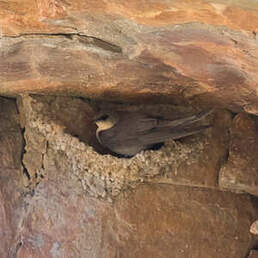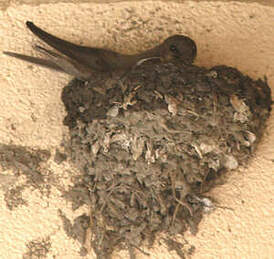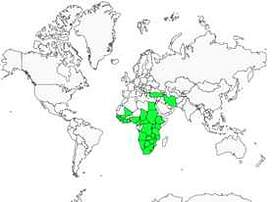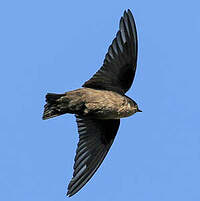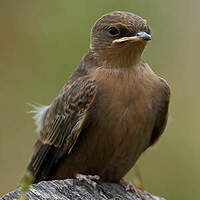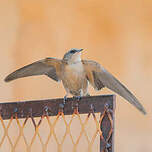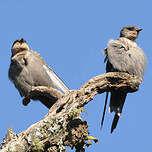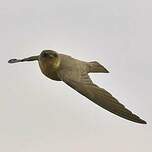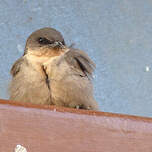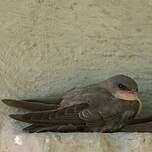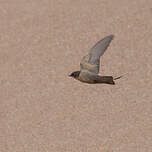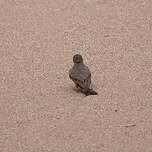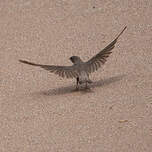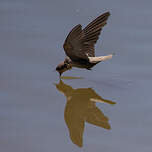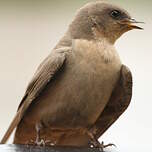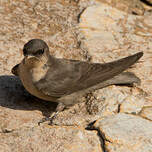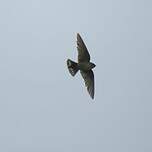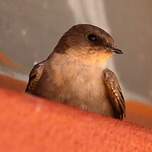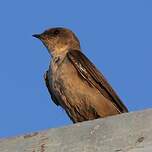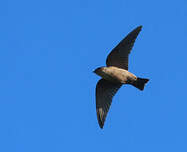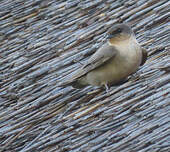Rock Martin
Ptyonoprogne fuligula - Hirondelle isabelline
Identification
The Rock Martin is a medium-sized swallow with drab plumage. The sexes are identical. The upperparts of the adult are dark sooty brown, with the wings and tail a little darker, which shows better in flight. The lores are sooty black. The chin, throat, sides of the neck and chest are lighter, a light beige tinged with shades of fawn. This shade extends to the undertail coverts which in flight contrast well with the remiges. The belly is darker, a brown shaded with fawn. The undertail coverts are very dark, with no contrast with the tail. The latter appears very unbordered, with white marks on the rectrices, as with the Rock Martin, except on the central and external ones. The eyes are dark. The bill and legs are sooty black. The juvenile resembles the adult, but with the upper tectrices edged with fawn.
The 6 subspecies differ only slightly in size and colour.
The Rock Martin can be confused with its congener, the Desert Swallow. However, it is somewhat larger and darker and is geographically separated from it. It could also be confused with a Swallow of the Shore, but the latter is smaller, with the underside much paler, has a dark chest band and has no white on the tail.
Subspecific information 5 subspecies
- Ptyonoprogne fuligula fuligula (s Namibia and w South Africa)
- Ptyonoprogne fuligula bansoensis (Sierra Leone to Nigeria and Cameroon)
- Ptyonoprogne fuligula rufigula (n Nigeria and Chad to Ethiopia south to Zimbabwe and n Mozambique.)
- Ptyonoprogne fuligula pretoriae (sw Zimbabwe and s Mozambique to e South Africa)
- Ptyonoprogne fuligula anderssoni (sw Angola , n and c Namibia)
Foreign names
- Hirondelle isabelline,
- Avión isabel meridional,
- andorinha-das-rochas-africana,
- Steinschwalbe,
- sivatagi szirtifecske,
- Kaapse Rotszwaluw,
- Rondine montana rupicola,
- afrikansk klippsvala,
- Ravinesvale,
- lastovička previsová,
- břehule hnědá,
- Bleg Klippesvale,
- afrikankalliopääsky,
- Kransswael,
- roquerol isabelí,
- Steinsvala,
- jaskółka blada,
- akmeņu čurkste,
- afriška skalna lastovka,
- Африканская скалистая ласточка,
- アフリカチャイロツバメ,
- 非洲岩燕,
- 非洲岩燕,
Voice song and cries
Rock Martins are vocally very discrete, and barely make any noise. The contact call is a sharp twit like that of a Sand Martin, and a rolling tcheurr that is similar to that of the Barn Swallow.
Their song is a gentle warbling.
Habitat
The Rock Martin replaces the Rock and Desert Swallow south of the Sahara. It frequents rocky habitats (coastal and inland cliffs, gorges, ravines, quarries, etc.
Behaviour character trait
These Rock Martins look for food alone, in pairs or in small groups, often joining other high-flying insectivores, other martins or swallows, particularly when there are hunting opportunities and/or an abundance of prey, such as during brushfires.
After the breeding season, they become more social and usually form small monospecific bands of several dozens of individuals, for example in South Africa where it is common. Urban roosts on buildings can gather several hundreds of individuals.
Coupling up occurs well before the start of reproduction. Once the nesting site is chosen, it is vigorously defended against congeners, or even other species.
Flight
Rock Martins have easy flapping flight which allows them to gain altitude quickly. They can circle for long periods without effort over mountain slopes thanks to the air currents. The flapping flights are interspersed with numerous glides, dives on prey followed by ascents. These birds are particularly active at dusk and at dawn.
Dietfeeding habits
Its diet is insectivorous. It hunts like other Rock Martins from the genus along mountain slopes, quite high above the ground, often in the company of other Rock Martins or swifts. Also over cities. They exploit what is known as aerial plankton made up of small flying insects (dipterans, hymenopterans, coleopterans, hemipterans, etc.). Usually, they hunt in pairs or small gangs. When they feed their young, they stay close to the nest.
Reproduction nesting
The breeding period varies depending on the region. In South Africa, Rock Martins typically nest from August to February, but in the Kalahari, at any time of the year after the rains.
In Central Africa, active nests are mainly visible from August to November and from January to April. In the Sahel, breeding is mainly springtime (March to June) or autumnal (October to December) depending on the rains.Rock Martins usually nest singly, but sometimes in colonies of several dozen pairs where the site allows and when the resource is abundant.
The nest of dried mud, including herbs and feathers, is an open cup quite similar to that of the Barn Swallow. Its exact shape depends on the rocky context. The nest is built by both partners, and its construction takes several weeks of work. Fortunately, its solidity allows it to be reused several years in a row. It is sometimes occupied at night outside the breeding season.
Rock Martins raise two broods a year, sometimes three. The cluTheeggs contain 2 or 3 chamois-colored or sepia-colored eggs with brown spots concentrated on the large end. The eggs measure 20 mm by 12 mm and weigh less than two grams.
The incubation period is 16 to 19 days and the feeding period is 24 to 30 days.
The fledging period is quite long, from 3 to 5 days. After the first departure, the young return to the nest several times before finally moving away and becoming independent.
Geographic range
The Rock Martin is an exclusively African and sub-Saharan swallow. Of the 6 recognised subspecies, 2 are from the Sahel, 3 are from South Africa and the last one spans the Equator, linking the other species together. The type subspecies fuligula is found in Namibia and South Africa. The species is known to be sedentary.
Threats - protection
IUCN conservation status
concern
in the Wild
threatened
evaluated
Rock Martins are relatively common birds, particularly in the south of their range. The species is not threatened. Birdlife assesses the status of the population as of least concern (LC).
Sources of information
- IOC World Bird List (v14.1), Gill, F and D Donsker (Eds). 2024-04-18.
- Vol. 9 - Handbook of the Birds of the world, Josep del Hoyo - Andrew Elliot - David Christie
- Swallows and Martins, Angela Turner
- Birds of Oklahoma, Bill Horn
- Wikipédia, Wikipedia, The Free Encyclopedia
- BirdLife International, BirdLife International
Other sources of interest
 Specification sheet created on
28/07/2023 by Jean François
Specification sheet created on
28/07/2023 by Jean FrançoisTranslation by AI Oiseaux.net
© 1996-2024 Oiseaux.net
- Accipitriformes
- Aegotheliformes
- Anseriformes
- Apodiformes
- Apterygiformes
- Bucerotiformes
- Caprimulgiformes
- Cariamiformes
- Casuariiformes
- Charadriiformes
- Ciconiiformes
- Coliiformes
- Columbiformes
- Coraciiformes
- Cuculiformes
- Eurypygiformes
- Falconiformes
- Galliformes
- Gaviiformes
- Gruiformes
- Leptosomiformes
- Mesitornithiformes
- Musophagiformes
- Nyctibiiformes
- Opisthocomiformes
- Otidiformes
- Passeriformes
- Pelecaniformes
- Phaethontiformes
- Phoenicopteriformes
- Piciformes
- Podargiformes
- Podicipediformes
- Procellariiformes
- Psittaciformes
- Pterocliformes
- Rheiformes
- Sphenisciformes
- Steatornithiformes
- Strigiformes
- Struthioniformes
- Suliformes
- Tinamiformes
- Trogoniformes

